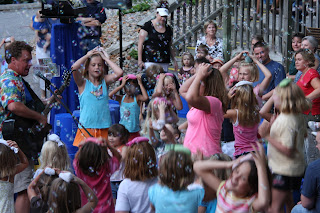It’s here!! Our
first Birds In Concert of 2013 is going to start off with a bang! Our first featured guest artist is the
hugely popular Babaloo.
Where else but WBS could you enjoy free family entertainment
that includes not only a concert, but live birds of prey and other animals?
Ready for something different? Then join us this Thursday night, August 1, for a high energy, often hilarious, musical comedy act for kids (and parents)
of all ages. Be warned—this is not
your usual run-of-the-mill kids’ crooner.
Babaloo’s show is fast-paced, totally interactive, full of fun props,
hilarious tunes and wacky stunts.
Everybody gets into the act!
This prize-winning pied piper packs more fun than seems
possible into every show, and he performs over 300 shows per year. The Children’s Music Web Awards named
him “Best Entertainer”, and he placed 1st and 2nd in the
world’s largest songwriting contest.
St. Louis Magazine voted him “The region’s best family entertainer” and
he’s a selected touring performer for the Missouri Arts Council and Mid-America
Arts Alliance.
Date: Thursday,
August 1, 2013
Time: 7:00 –
8:30 pm
Admission and Parking:
FREE!
Snacks and beverages may be purchased from our concession
stand—or bring your own picnics and blankets. Since Babaloo usually draws a full house you may want to
bring blankets or folding chairs to take advantage of lawn seating.
Following is the full schedule of artists and dates for
Birds In Concert 2013:
August 1 – Babaloo followed by The Raptor Project
August 8 – The Raptor Project performs songs from their CD’s
August 15 – The Raptor Project followed by The Reserve
featuring Javier Mendoza and Jim Peters
August 22 – The
Raptor Project followed by Fowl Play
For the safety of our guests and animals--please no pets.















.jpg)
.jpg)
.JPG)




















